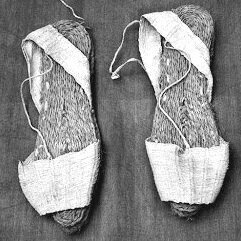Our
History
Es Par Ta was founded upon and inspired by the poetry of an object that comes from humble origins. The simplicity, form and function of this ancient shoe has helped it maintain its identity, through the success of revivals and reinventions.
A NATURAL THREAD THROUGH CULTURE AND TIME
Sandals made from grass have been discovered in Egyptian, Roman and Native American archeological sites and have been traditionally worn in many parts of Africa and Asia. But, it is the Spanish espadrille (also known as an alpargata or espartena) that have become historically and internationally known. In its most basic form, a jute sole (originally made of esparto grass) is plaited, coiled and sewn to a textile upper, creating a resilient, breathable, and comfortable shoe that is both biodegradable and recyclable.
A SPANISH IDENTITY
An early espadrille from Cueva de los Murciélagos of Albuñol in Granada dates back to the sixth century BCE, while others have been discovered in the Pyrenees throughout history. Shoemaking has long been an important industry in Spain and the growing textile industry in Catalonia contributed to its espadrille production. In the nineteenth and early twentieth centuries, espadrilles were worn by farm workers, fishermen, and priests - but it wasn't until the 1930s that they began to appear as practical leisure wear throughout Europe. During this period, manufacturers began painting the jute sole with rubber, increasing its resilience.
A SOURCE OF CATALAN PRIDE
Rooted in Catalan culture, each region claims its own typical espadrille, defined by the shape, color or the application of the ribbons. Catalans still order special espardenyas for dancing the sardana. The national dance of Catalonia, which was outlawed for much of Franco's rule, is a circle dance that represents brotherhood, equality and liberty. Picasso used it as an image in lithographs and ceramics, a symbol of youth and peace. Salvador Dali, was known to pair his espadrilles with a light summer suit and a Panama hat, while Italian director, Michelangelo Antonioni favored a style from Valls, close to Tarragona.
INTERNATIONAL SUCCESS
Italian shoe designer, Salvatore Ferragamo, could be credited with elevating the espadrille to a stylish streetwear staple. Trade embargoes against Italy in the 1930s and 40s led to a scarcity of materials, including high-quality leather. Ferragamo made creative use of raffia, cork and textiles and he debuted a style in 1937 with a wedge heel wrapped in braided rope. Starlets, Lauren Bacall and Grace Kelley led the trend forward, wearing espadrilles in their respective film features of the time. Forty years later, Yves Saint Laurent reinvented the espadrille yet again, working with a traditional Catalan shoemaker to wrap braided jute around a wedge sole. Color and high ankle ties were added to a runway style, ignited a trend in 1976. Since then, designers have often introduced luxury footwear that evokes the traditional, utilitarian alpargata.




